Steel Products Prices North America

Steelmaking Raw Materials Update: Price Declines Continue
Written by David Schollaert
June 6, 2023
Editor’s note: Steel Market Update is pleased to share this Premium content with Executive members. For information on how to upgrade to a Premium-level subscription, contact Lindsey Fox at lindsey@steelmarketupdate.com.
Prices of steelmaking raw materials have been largely on the decline over the last 30 days, as they were the month prior, the exception being pig iron, according to SMU’s latest analysis.
Through the latest data available as of May 31, the table below details the latest shifts. Zinc and coking coal saw the largest declines month-on-month (MoM), down 15% and 13%, respectively.
Iron ore and scrap saw similar declines, though not as significant. And while aluminum seems to be trumping the trend with a 17% MoM gain, the increase was driven by a trading surge to close out the month, but by June 1 prices would swing 28 percentage points to an 11% decline.
At the start of 2023 we saw consecutive monthly increases for all products as seasonality and supply-side deficits drove prices up. The trend has shifted over the past couple of months as demand has settled a bit ahead of summer.
Compared to levels three months ago, prices for five of the seven raw materials in this analysis have declined, one is unchanged, and two increased. Six materials are priced below levels one year ago, with multiple products down by 25% or more.
Table 1 summarizes the price changes of the seven materials considered in this analysis. It reports the percentage change from one month, three months, and one year prior for each product.
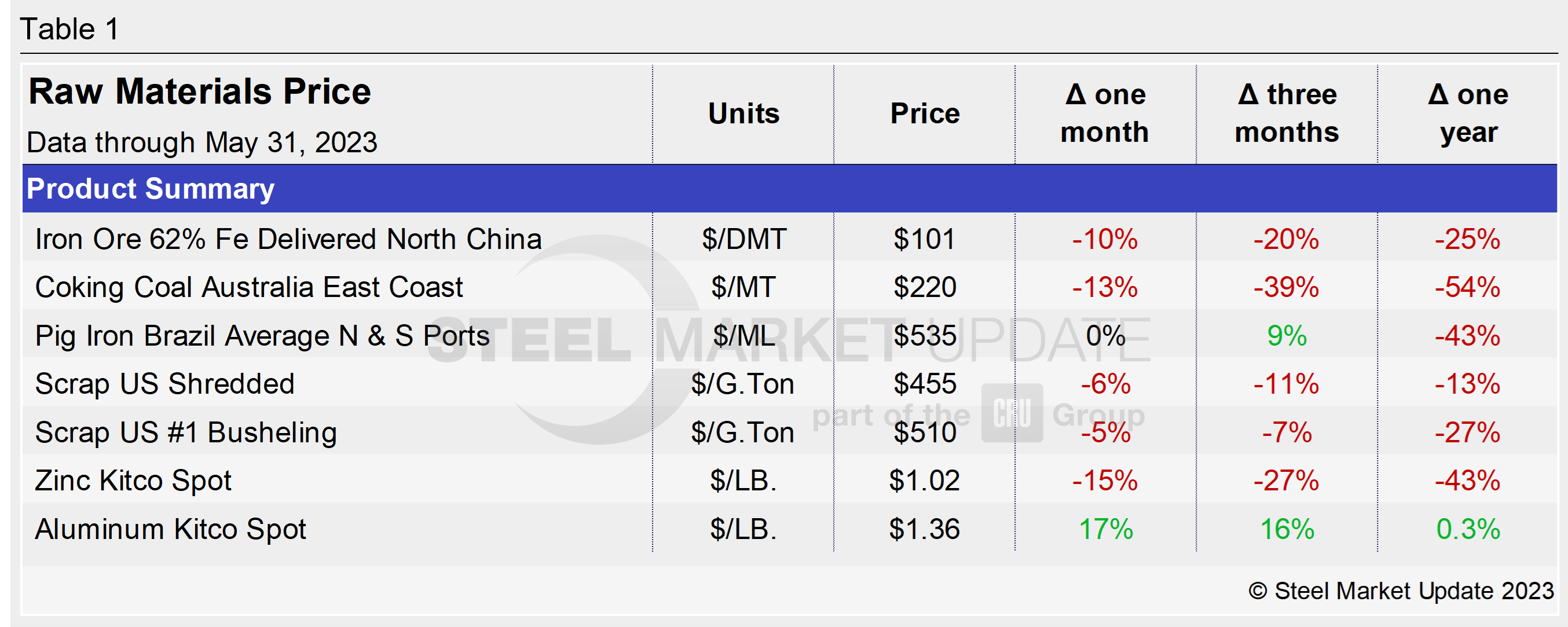
Iron Ore
After rising to record-high levels last summer, the Chinese import price of 62% Fe content iron ore fines receded to pre-Covid levels by the end of 2021. Prices rose through the first half of 2022 before steadily declining to a 2.5-year low of $82 per dry metric ton (DMT) in December. Figure 1 shows the price of 62% Fe delivered North China at $101 per DMT as of May 31. Iron ore prices are presently on a steady decline since reaching a most recent high of $130 per DMT in mid-March.
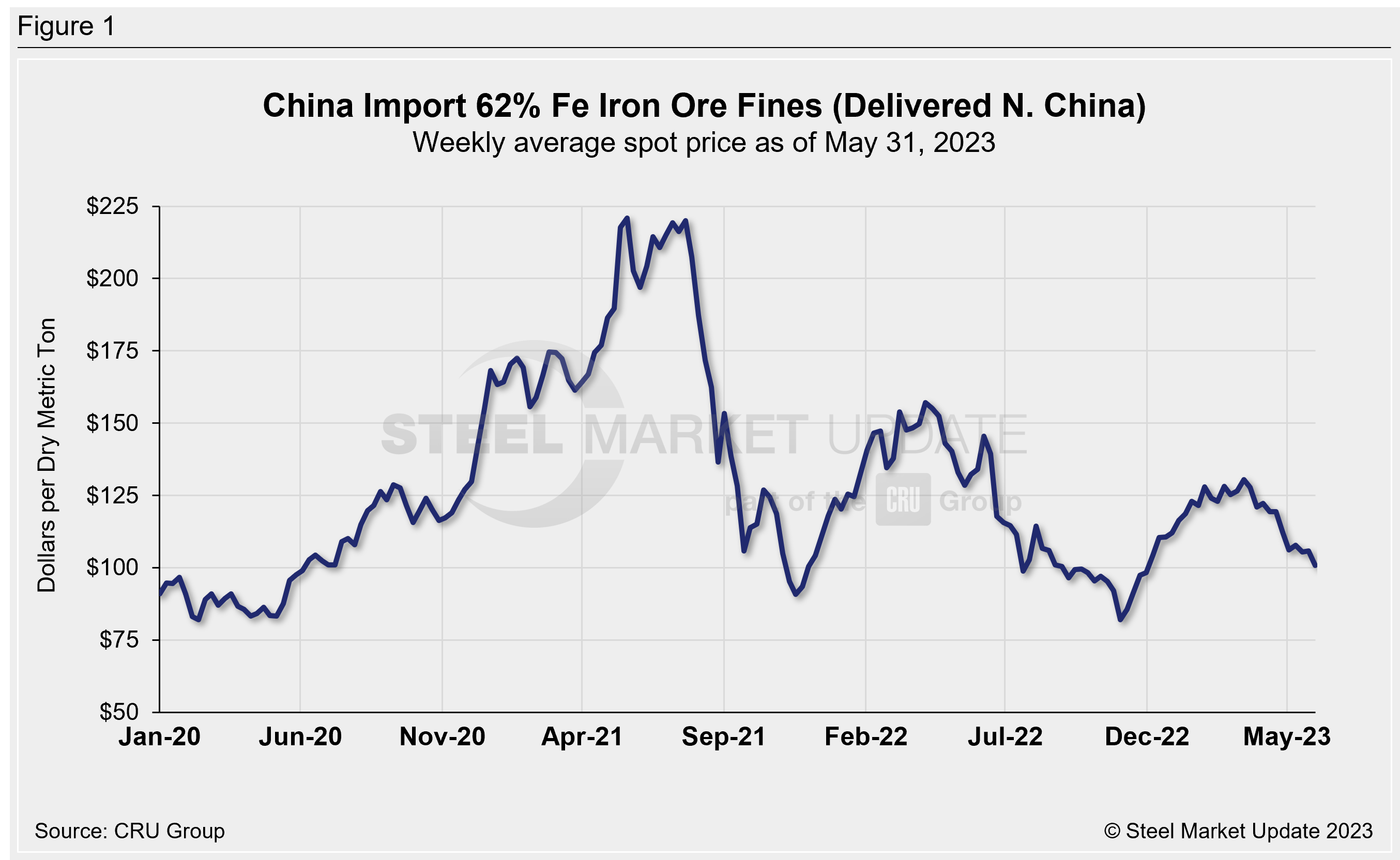
Coking Coal
The price of premium hard coking coal FOB east coast of Australia surged in March of last year to a record high of $660 per DMT. Prices quickly declined in the following months, falling to a 13-month low of $193 per DMT in early August. Prices then ticked back up, reaching the most recent peak of $390 per DMT before sliding to a present low of $220 per DMT as of May 31 (Figure 2). Prices are down nearly 40% compared to three months prior and are down 54% from prices one year ago. For comparison, the average coking coal price between 2017–2020 was $172 per DMT.
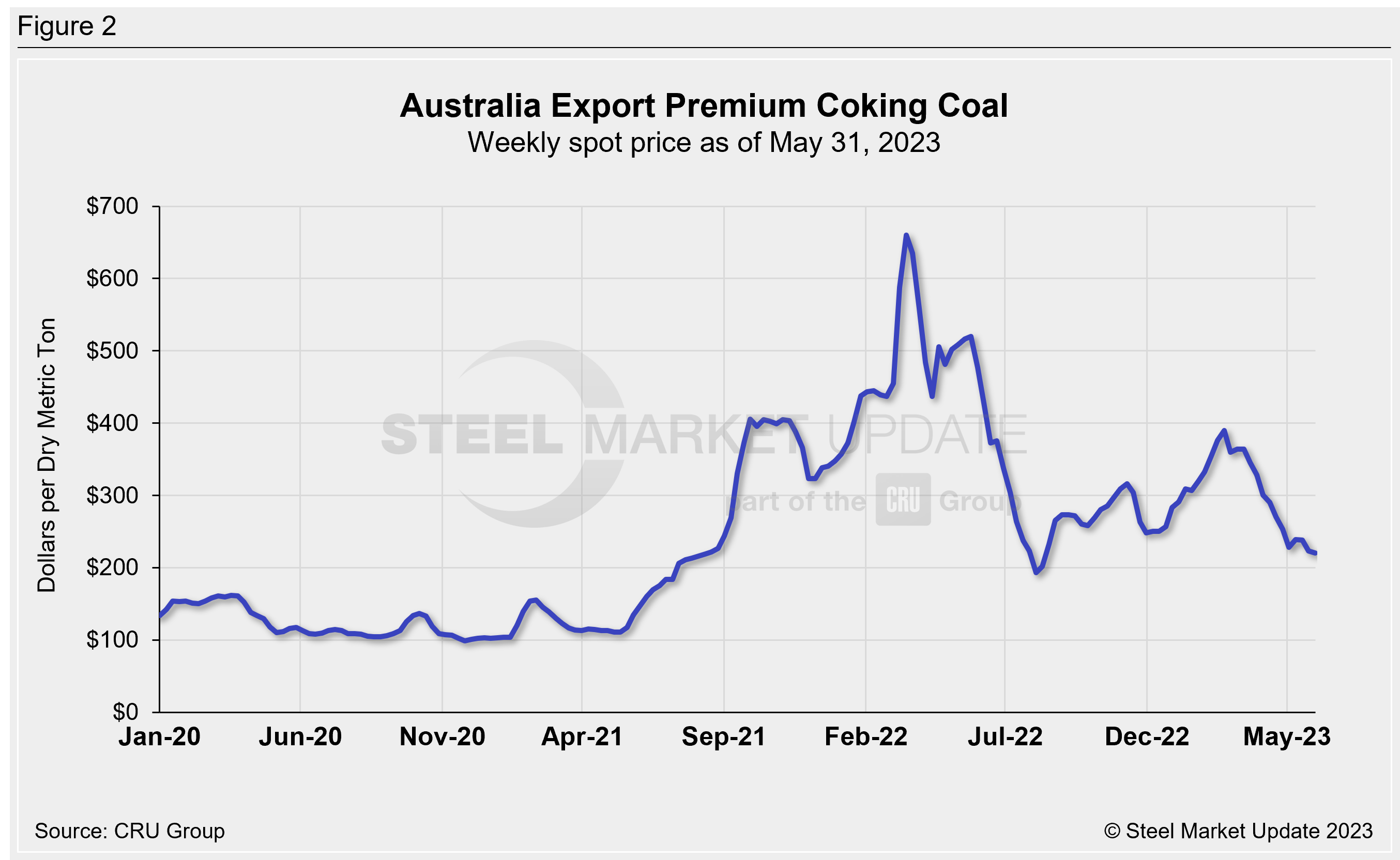
Pig Iron
Most of the pig iron imported to the US had come from Russia, Ukraine, and Brazil. This report summarizes prices out of Brazil and averages the FOB value from the north and south ports.
Pig iron prices had remained elevated but stable for most of 2021 and early 2022. Prices jumped 60% in March following the invasion of Ukraine by Russian forces, which limited or halted supplies from both nations. April saw record-high pig iron prices of $975 per DMT. Prices then eased, falling to a recent low of $430 per DMT last October. Pig iron tags have been tending up since, currently at $520 per DMT as of June 1 (Figure 3).
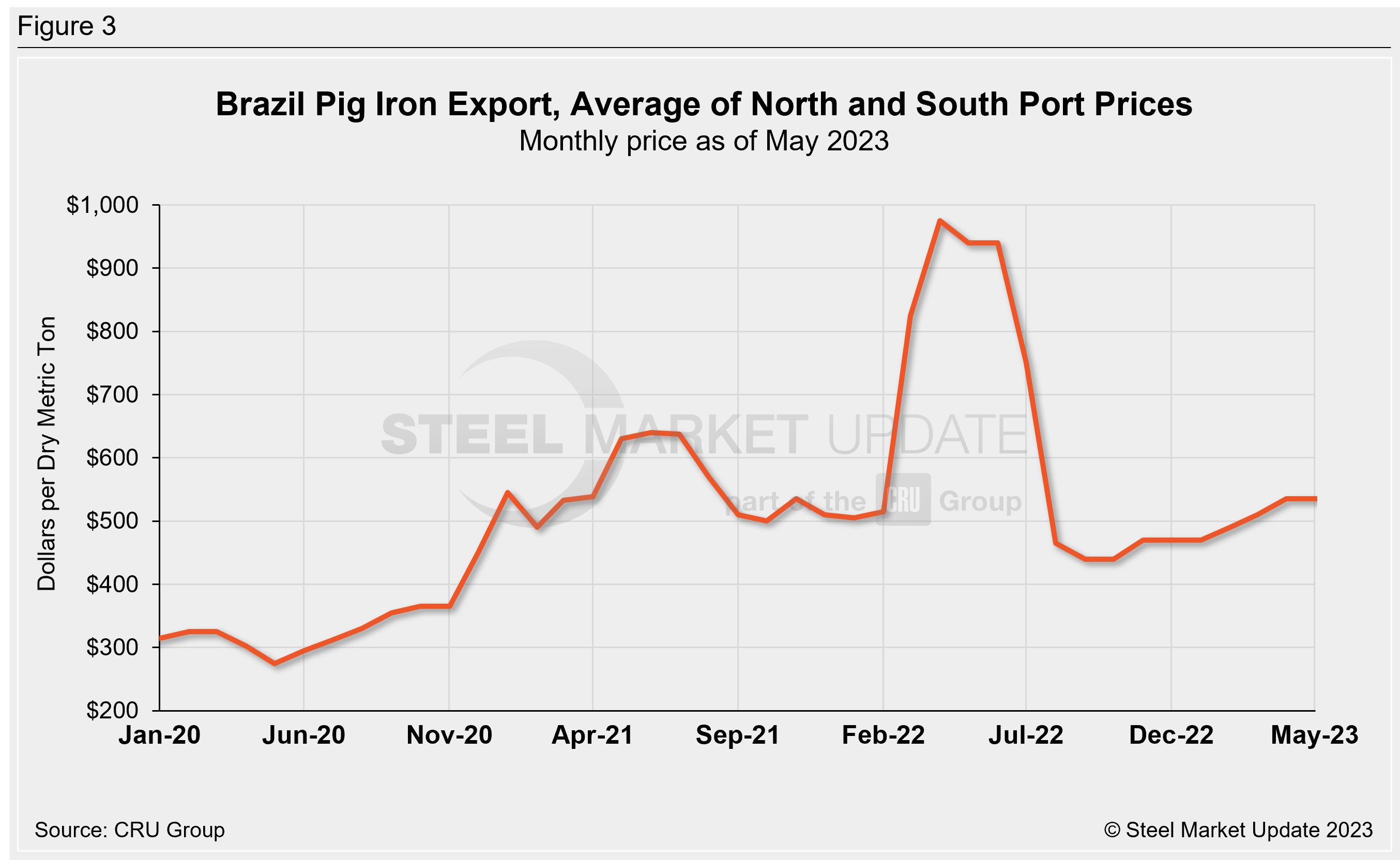
Scrap
Hot-rolled steel prices fluctuate up and down with the price the mills must pay for their raw materials. Changes in the relationship between scrap and iron ore prices offer insights into the competitiveness of integrated mills, whose primary feedstock is iron ore, compared to minimills, whose primary feedstock is scrap. Figure 4 shows the spread between shredded and busheling scrap, priced in dollars per gross ton in the Great Lakes region.
Scrap prices were on an eight-month decline to close our 2022 before reversing course in December, then rose repeatedly through March. Busheling scrap rose by $205 per gross ton over that period, while shredded scrap increased $140 per gross ton. Recall that March and April of last year saw record-high scrap prices, with busheling reaching $775 and shred hitting $600 per gross ton. Prior to 2021, the highest point for scrap prices over the last decade was $510 per gross ton for busheling in 2011 and $473 per gross ton for shredded in 2012. Prices are presently $455 and $510 per gross ton for shredded and busheling, respectively, through May.
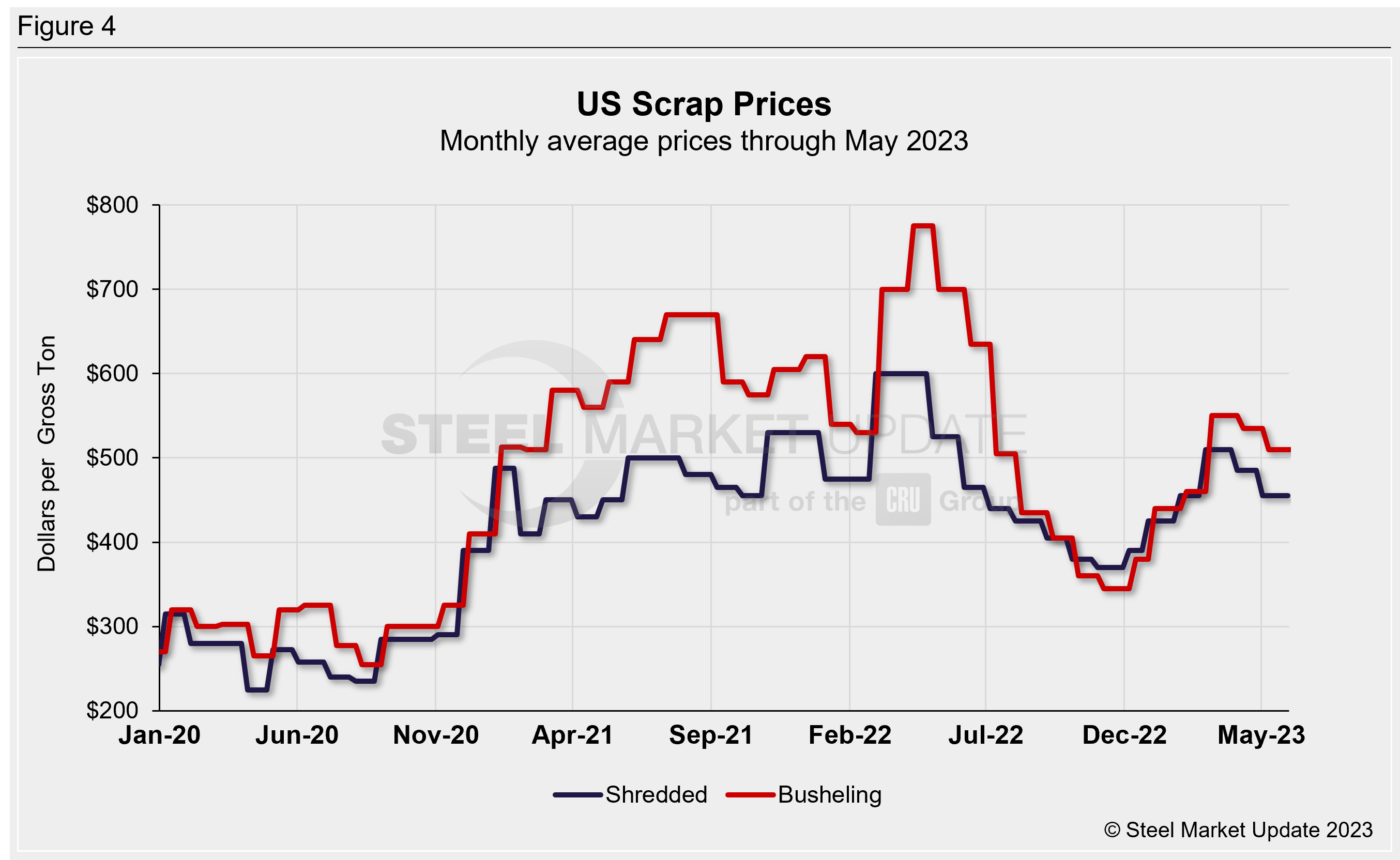
Figure 5 shows the prices of mill raw materials over the past three years. Iron ore prices are 52% below the May 2021 peak of $221 per DMT, and still 21% below prices this time last year. Shredded scrap prices are down 38% from the March/April 2022 high, and down 30% versus levels one year ago.
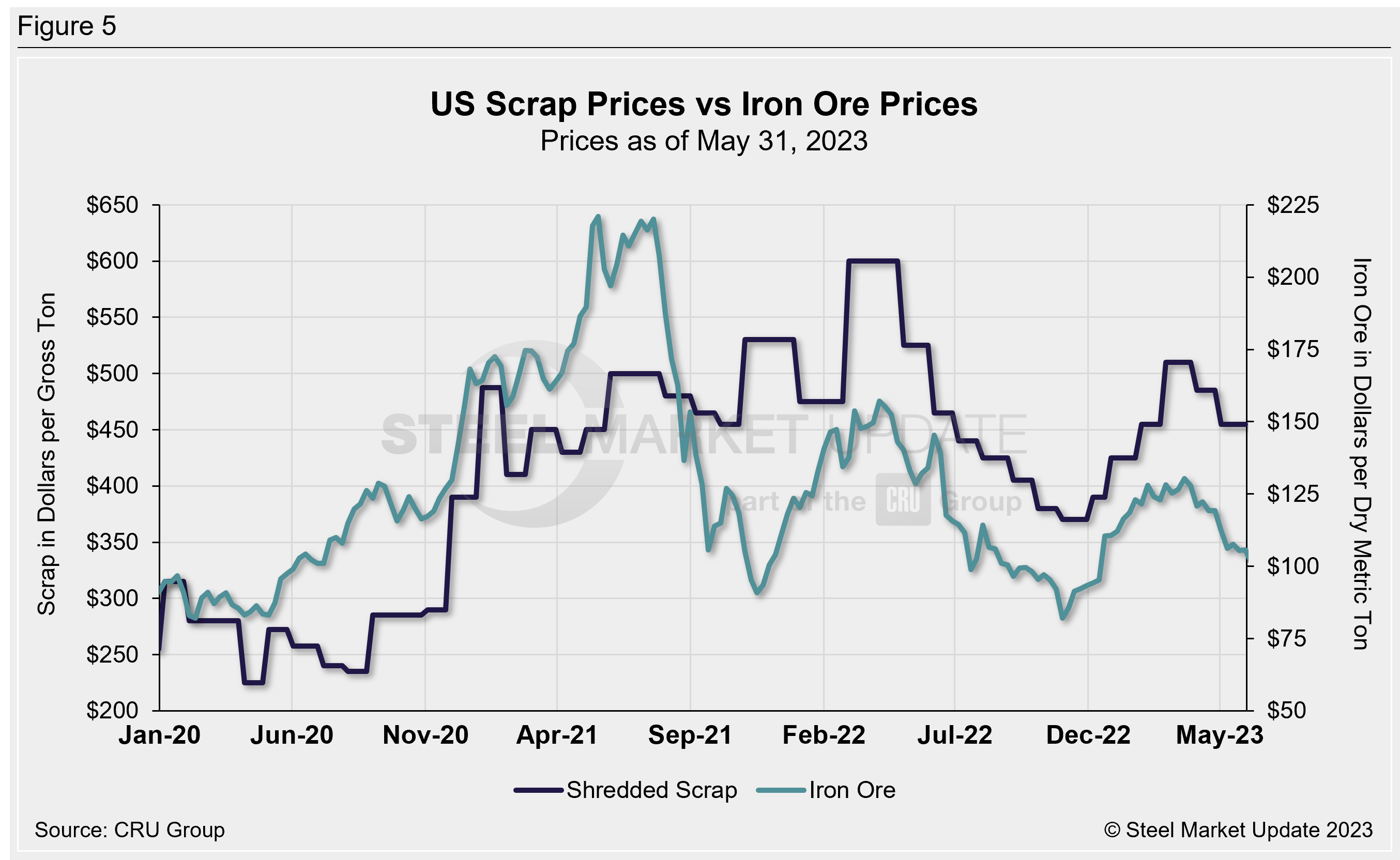
To compare the two, SMU divides the shredded scrap price by the iron ore price to calculate a ratio (Figure 6). A high ratio favors the integrated/BF producers, and a lower ratio favors the minimill/EAF producers.
At the current 4.30 ratio shown below, integrated producers have mostly held onto the cost advantage since March. Back in November 2021 we saw a ratio of 5.84, the highest since mid-2018. The scrap-to-iron ore ratio reached a record low (within SMU’s 12-year data history) of 1.86 in August 2020.
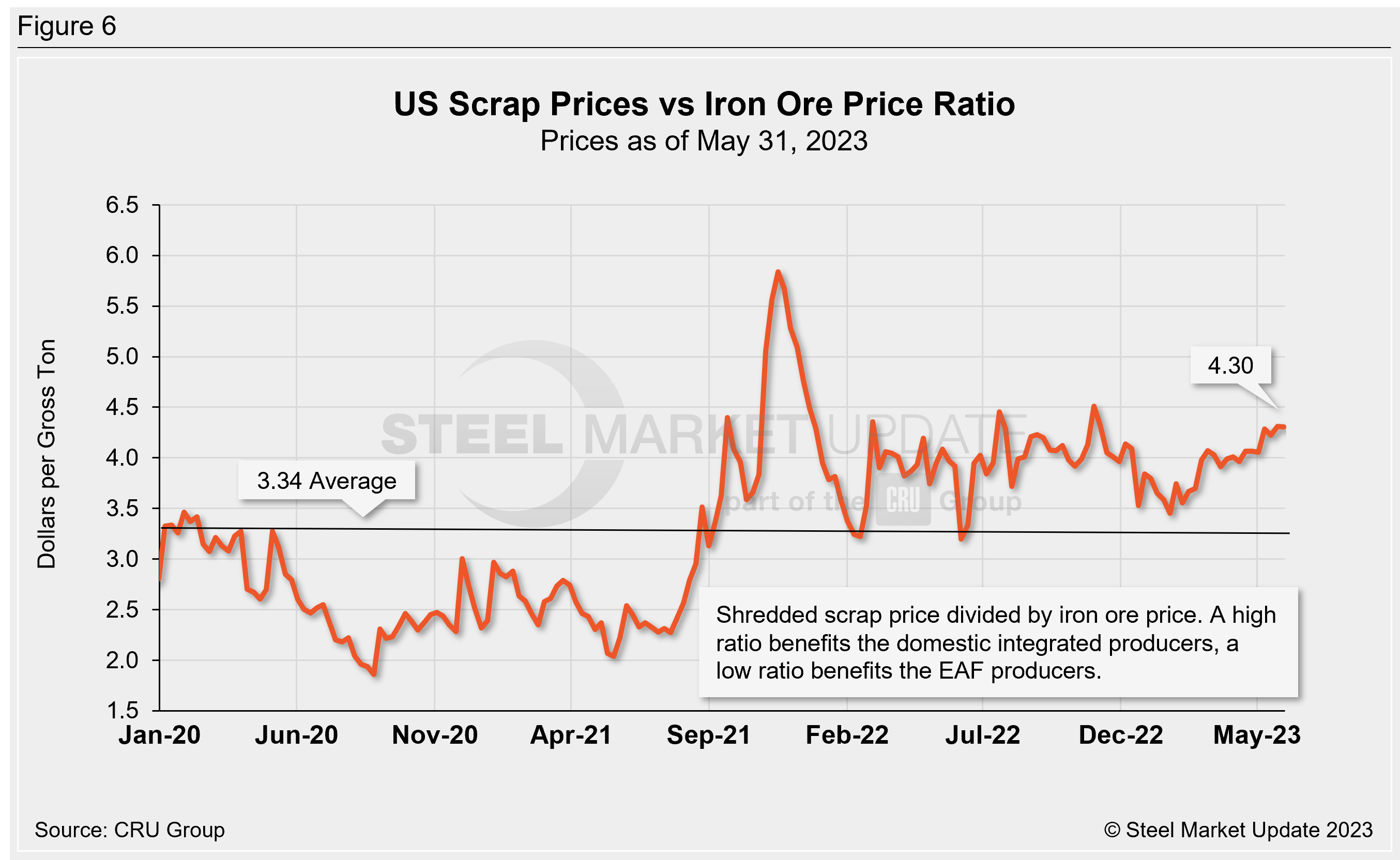
Figure 7 shows how the price of hot-rolled steel relates to the price of busheling scrap. Busheling remains down $265 per gross ton (34%) from the April 2020 peak but is still above the pre-pandemic ballpark. As of Tuesday, May 30, the SMU hot rolled price average was $990 per ton, unchanged week-over-week, but down $140 per ton from the recent mid-April high of $1,160 per ton.
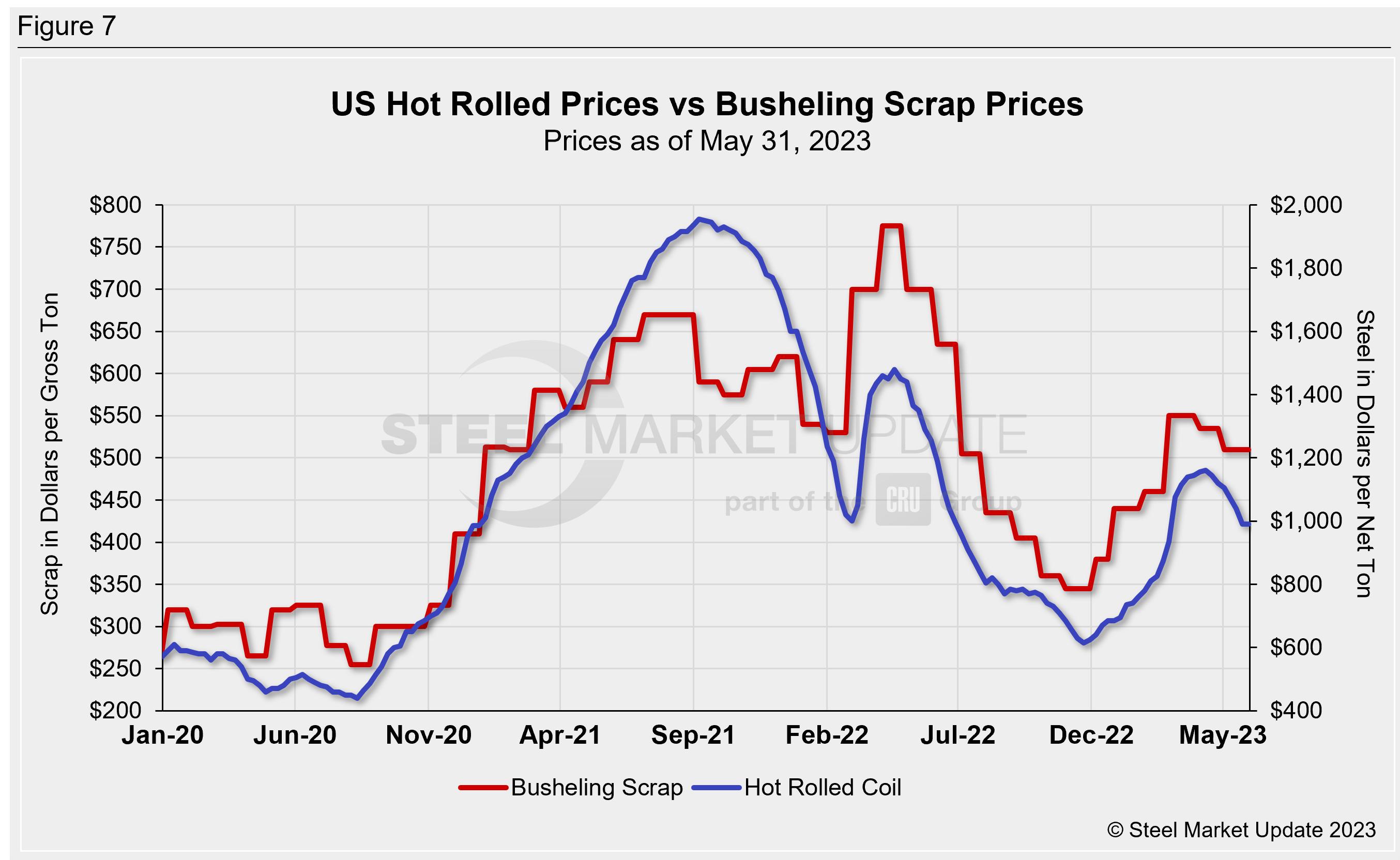
Zinc and Aluminum
Zinc is used in galvanized and other coated steel products. Spot prices have fluctuated dramatically in the past year-and-a-half; the LME cash price for zinc reached a record high of $2.05 per pound last May, declining through July to reach a ten-month low of $1.35 per pound. Prices picked back up and fluctuated higher through January to reach a high of $1.74 per pound. They have since eroded steadily, reaching the lowest mark in nearly three years of $1.02 per pound on May 31. (Figure 8).
Aluminum prices, which factor into the price of Galvalume, have seen a very similar trend to zinc. They had been on the rise in 2021 and into early 2022, reaching a record-high of $1.76 per pound on March 23. (Note that aluminum spot prices often have large swings and return to typical levels within a few days, as seen in the graphic below. We do not consider those surges in our overall high/low comparisons.) Aluminum prices had been relatively stable since June 2022 but then declined to a 17-month low of $1.05 per pound in late last September. The LME cash price turned and reached a recent high of $1.33 per pound on Jan. 25. Aluminum prices have declined to a nearly three-year low of $1.03 on June 2.
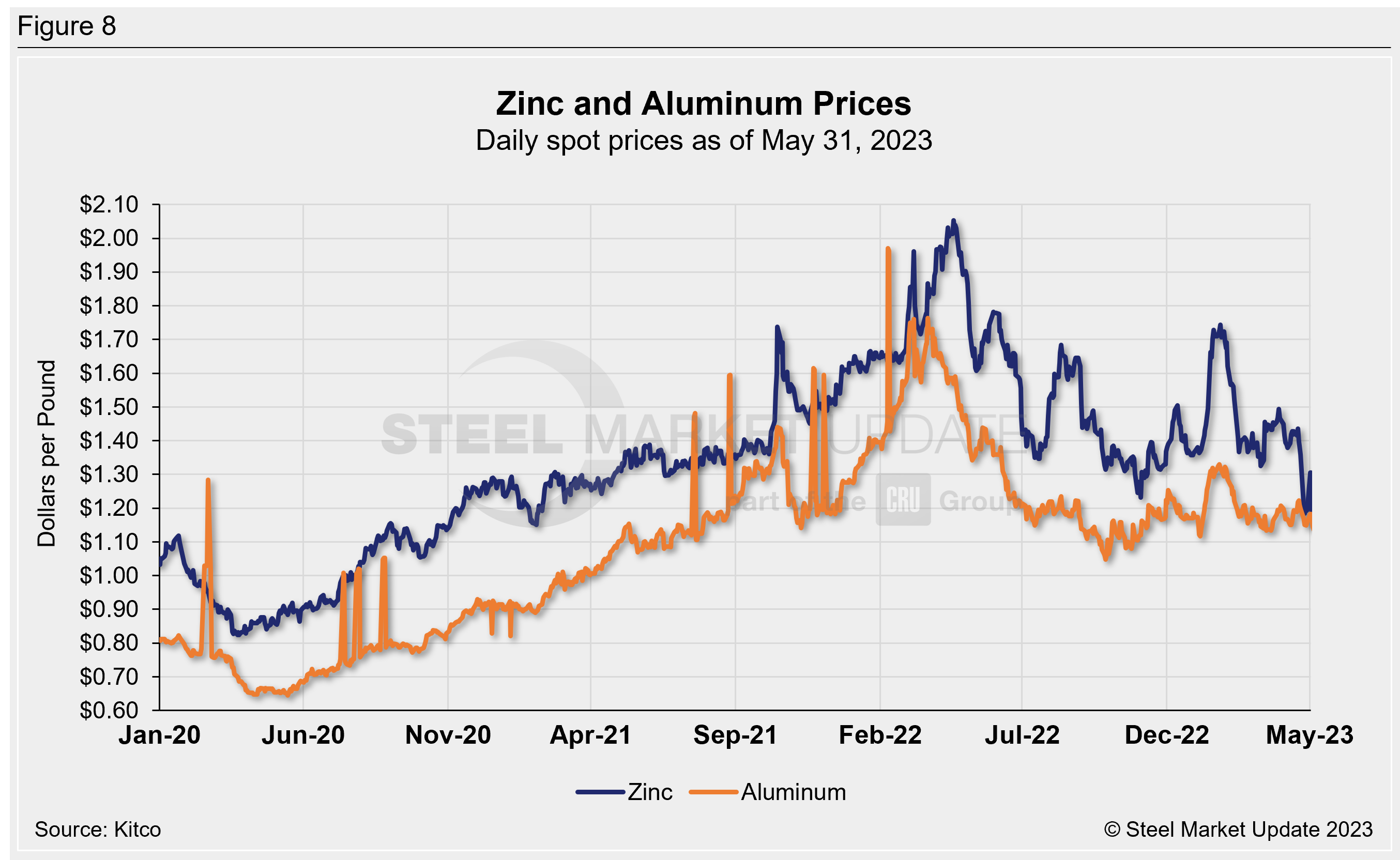
By David Schollaert, david@steelmarketupdate.com

David Schollaert
Read more from David SchollaertLatest in Steel Products Prices North America

CRU: US rebar and wire rod prices rise alongside S232 increase
CRU Senior Steel Analyst Alexandra Anderson discusses current market and pricing dynamics for long steel products in the US.

SMU Price Ranges: Sheet and plate steady ahead of Independence Day
Sheet and plate prices were little changed in the shortened week ahead of Independence Day, according to SMU’s latest check of the market.

Nucor maintains plate prices, opens August order book
Nucor aims to keep plate prices flat again with the opening of its August order book.

Nucor CSP remains level at $900/ton
Nucor maintained its weekly list price for hot-rolled (HR) coil this week, following two consecutive increases.

Cliffs raises prices, seeks $950/ton for July spot HR
Cleveland-Cliffs plans to increase prices for hot-rolled (HR) coil to $950 per short ton (st) with the opening of its July spot order book. The Cleveland-based steelmaker said the price hike was effective immediately in a letter to customers dated Monday.
